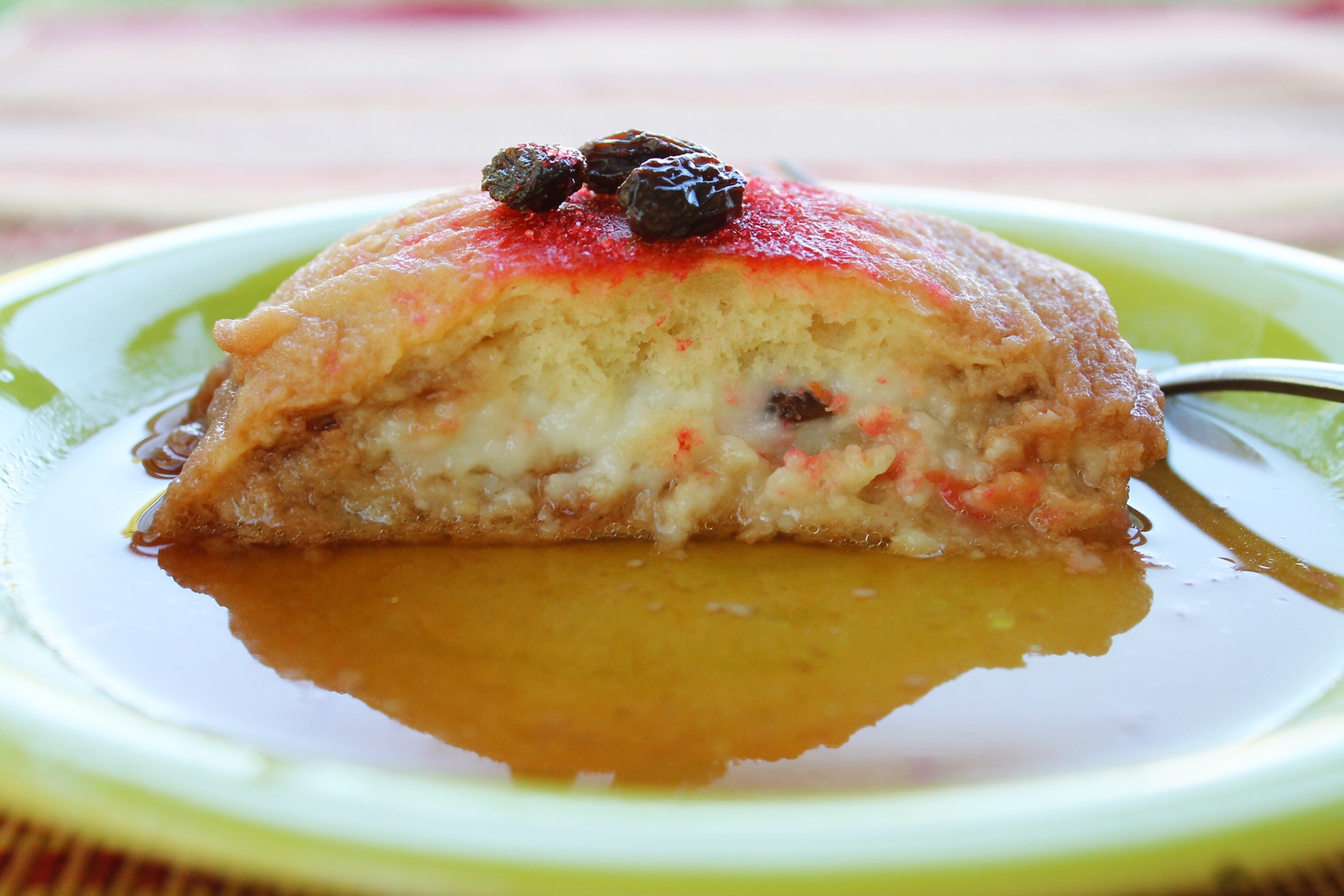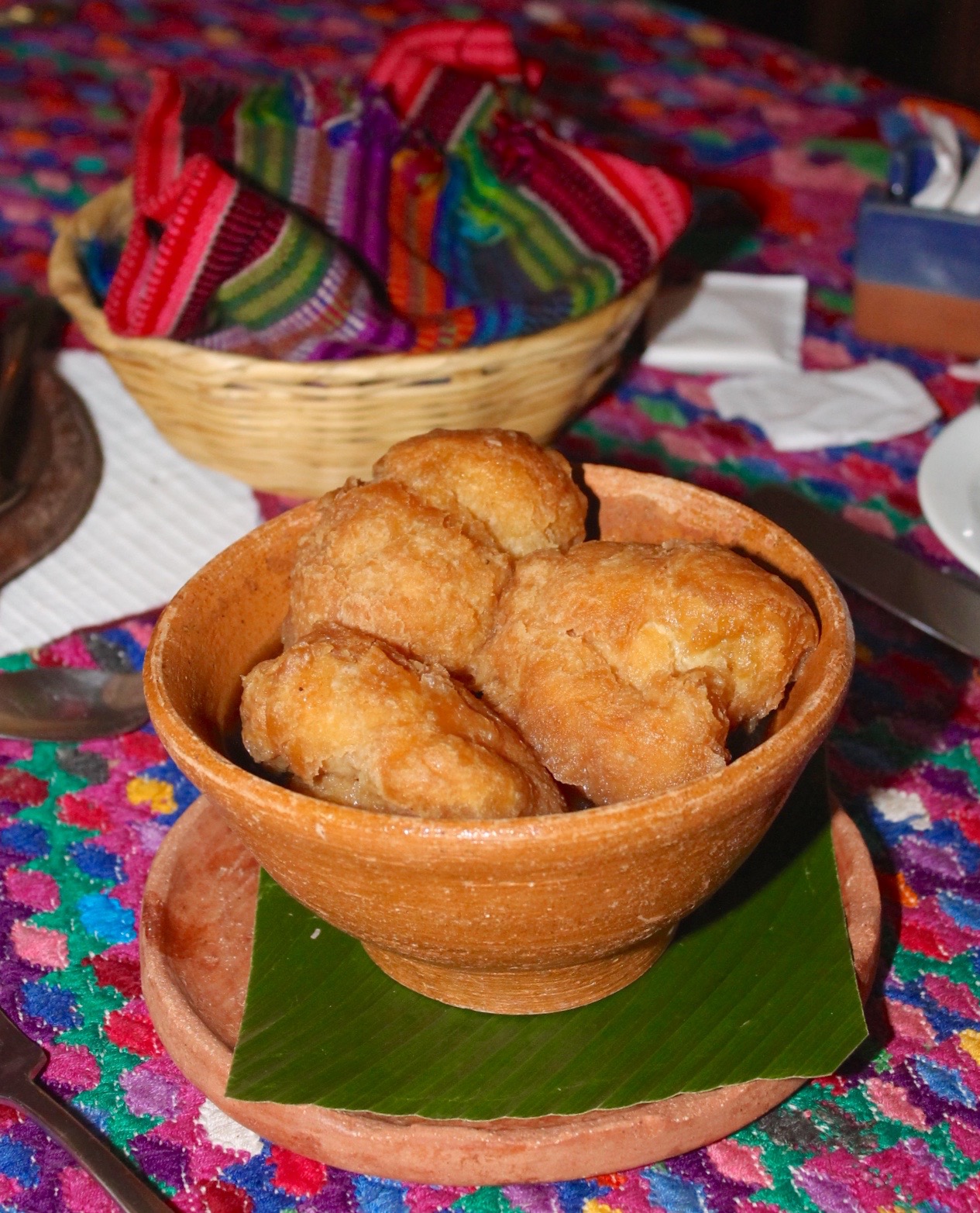This post is also available in: Español
Torrejas is a typical Guatemalan dessert very popular during Christmas and Lent. They are the Latin American version of the French toast, and everyone makes them a little different. There are also many different versions of the Guatemalan recipe for Torrejas. I chose this one because it is somewhat easier, and I made sure the ingredients were easy to find. It is customary to add rum to the syrup, but I went for a kid-friendly recipe here. Sometimes torrejas and molletes are used interchangeably, but in Guatemala, these are two different dishes.

An Easy and Delicious Recipe for Guatemalan Torrejas
If you have a craving for something sweet, then Guatemalan torrejas should be at the top of the list. This mouthwatering Guatemalan dessert is commonly found at fairs and is very popular during Easter and Christmas.
You can buy pan dulce (sweet bread) to make this mouthwatering recipe. Still, I love making them out of any leftover bread I have lying around the kitchen. I would strongly recommend picking bread on the stiff side, so it doesn’t crumble when soaked in the delicious syrup.
What is a Guatemalan Torreja?
Referred often as the Guatemalan French toasts, the torrejas are sweet bread or brioche soaked in a milk or eggs mixture before being fried in oil. Then, you usually bathe them in a sweet syrup made from boiling water and spices into a golden brown sauce. It is a huge part of traditional Guatemalan cuisine, especially during Lent and Christmas.
The soaked bread is present in many cultures throughout the world and was introduced into Latin America by the Spanish. Soaking stale bread in a sweet syrup gives it a delicious texture.
Even within Guatemala, there are different versions of this traditional dish. Some recipes add a little bit of rum to the syrup or orange zest. My recipe has no alcohol, as I made it a kid-friendly dessert. But feel free to pour a couple of tablespoons of rum which will add a distinctive fruity flavor to the torrejas.

What are the Ingredients for Guatemalan Torrejas?
The main ingredient for Guatemalan torrejas is the pan dulce (sweet bread) dunked in an egg-and-flour mixture and fried in oil or butter, just like French toasts. Then, you bathe it in a sweet syrup made from water, sugar, allspice, cloves, and cinnamon to soak in all the flavors. Finally, many chapines add a touch of rum or orange or lime zest to give it a little punch.
Torrejas vs. Molletes
Even though Guatemalans sometimes use both terms interchangeably, these are two different dishes. Torrejas are whole sweet bread dipped in an egg mixture, fried and soaked in a rich syrup, while molletes are cut in half and usually filled with creamy custard.

Both Guatemalan recipes have spices and raisins boiled in a sugary syrup, so the main difference is the stuffing. The molletes are filled with a creamy custard called manjar that gives the dish a different texture. And while the torrejas lack filling, they are a traditional Guatemalan dessert that will make your mouth water! If you want to try making molletes check out the recipe here.
As a side note, Guatemalan Molletes are an entirely different dish than Mexican molletes. As you can see, the Guatemalan version is a traditional dish made from sweet bread, while Mexican molletes are open-face sandwiches with black beans and melted cheese. To taste the difference, try out my easy recipe for this traditional Mexican sandwich.
How to Make Guatemalan Torrejas:
Ingredients for the Torrejas
- 2 eggs
- 2 tablespoons of flour
- 12 panes dulces o panes de manteca (lard or sweet bread similar to Mexican conchas), or you can also use brioche bread
- 2 cups of vegetable oil
Ingredients for the Syrup
- 1 lb. sugar
- 3 cups of water
- zest from one orange
- ½ teaspoon allspice
- 3 cloves
- 1 cinnamon stick
- 2 ounces of raisins
- 4 ounces of prunes
Directions
- Beat the eggs until they form stiff peaks; add the flour and mix it in carefully. Pass the bread through the egg mixture until they are completely covered.
- Fry in hot oil, making sure to turn them around once to cook on both sides. Next, place the fried bread in a colander and pour hot water over and let them drain. It is so that the bread does not become too greasy.
- To make the syrup: On a large pot, bring the water to a boil, add the sugar, orange zest, allspice, cloves, and cinnamon until a thin syrup is obtained (about 10 to 15 minutes). Finally, add the raisins and prunes.
- Place the Torrejas in the syrup and let them soak for a couple of minutes. Serve with a prune in the center and sprinkle with sugar.

Make Ahead of Time
Even though you can refrigerate it for up to 3 days, it is best to enjoy this dish immediately after making it. Every time you fry something, it is best to eat it right away, or the grease could break up and make the dish soggy and greasy. And since my recipe is so easy to make, you can whisk a batch of torrejas for breakfast for the kids or as a delicious dessert after a great family gathering.
Tips for Making the Best Guatemalan Torrejas:
- Don’t throw away old bread! Although I used a specific kind of sweet bread, you can change it for any leftover loaves you have at home. The trick is letting the bread soak in the delicious syrup!
- Small batches work better: I like doing it in small loads when it is time to fry the bread, so the oil doesn’t go cold. Also, it keeps the bread crispier and holds better when it goes into the syrup.
- Serve them cold or hot? Honestly, I love them either way! If it is cold outside, I serve them in a bowl of hot syrup. But if I’m planning a picnic, I place them on an airtight container, and my kids gulp them down at room temperature. And my husband loves eating them right out of the fridge! But hot or cold, I promise you will love both ways as much as my family does!
What To Serve with Traditional Guatemalan Torrejas?
The sweet taste of the torrejas is the perfect ending to any meal! I love mixing different textures in every course when I plan a menu, like cooking Guatemalan enchiladas. The crunchiness of the tortilla topped with the escabeche and ground beef goes great with the sweetness of the torreja bread.
Since this is a very versatile dessert that doesn’t have an overpowering taste, you can make it with any of your favorite recipes. And with its delightful texture and sugary taste, my kids love them for breakfast, lunch, and dinner!
Other Traditional Guatemalan Dessert Recipes:
- Rellenitos de Plátano: Tasty ripe plantains filled with beans and covered in sugar. Although the combination might seem strange, this sweet plantain recipe is one of the most delicious Guatemalan foods

- Canillitas de Leche: Try a quick and easy recipe for canillitas, a delicious 10-minute dessert that uses only three ingredients you already have in your pantry.
- Easy Pineapple Empanadas: These easy-to-make empanadas are a great dessert or a quick sweet snack. They travel well and are perfect for entertaining, ideal for picnics, BBQs, or potlucks.
- Champurradas: A super easy recipe that will surely be a total success with everyone in the family! A scrumptious giant cookie with the perfect level of crunch to dunk in your morning coffee!
- Guatemalan Buñuelos: A fried wheat-based dough balls, crisp on the outside and soft inside, covered in white sugar. Serve this delicious Guatemalan dessert in a light syrup your kids will love!

I love posting recipes from my home country of Guatemala, traditional dishes I can cook and enjoy at any time. I hope you enjoy this easy yet delicious recipe for torrejas, a Guatemalan dessert that is full of sweetness and flavor. If you have any suggestions or want a specific traditional Guatemalan recipe, let me know in the comments section.
¡Buen Provecho!

Guatemalan Torrejas
A quick and easy recipe for Guatemalan Torrejas, a delicious pan dulce or sweet bread soaked in a rich syrup!
Ingredients
For the Torrejas
- 2 eggs
- 2 tablespoons of flour
- 12 panes dulces o panes de manteca (lard or sweet bread similar to Mexican conchas), or you can also use brioche bread
- 2 cups of vegetable oil
for the Syrup
- 1 lb. sugar
- 3 cups of water
- zest from one orange
- ½ teaspoon allspice
- 3 cloves
- 1 cinnamon stick
- 2 ounces of raisins
- 4 ounces of prunes
Instructions
1.Beat the eggs until they form stiff peaks; add the flour and mix it in carefully. Pass the bread through the egg mixture until they are completely covered.
2.Fry in hot oil, making sure to turn them around once to cook on both sides. Next, place the fried bread in a colander and pour hot water over and let them drain. It is so that the bread does not become too greasy.
3.To make the syrup: On a large pot, bring the water to a boil, add the sugar, orange zest, allspice, cloves, and cinnamon until a thin syrup is obtained (about 10 to 15 minutes). Finally, add the raisins and prunes.
4.Place the Torrejas in the syrup and let them soak for a couple of minutes. Serve with a prune in the center and sprinkle with sugar.
Notes
You can add a couple of tablespoons of rum to the syrup that will add a distinctive fruity flavor to the torrejas.
Nutrition Information:
Serving Size: 1 torrejaAmount Per Serving: Calories: 190



Hi Paula,
I am hosting a Guatemalan dinner party for six people and I am looking for some traditional Guatemalan recipes to make. I would love to get some Mayan recipes in there too, but all the food looks so good! Ideally, I’d like to be able to make it ahead so I don’t have to cook at the party. I would love to get some recipes and dinner traditions from a native Guatemalan! 🙂
Saludos desde Inglaterra 🙂
Hola Patty! Saludos, me encanta tu blog está fantástico.
perdon, pero estas torrejas se paresen a las guatemaltecas pero no son, ademas es la primera vez que leo que las torrejas son un postre tradicional de la navidad, si mi memoria no me falla y si no estoy mal es un plato exclusivo de la semana santa, asi como lo es el pescado seco, pero tal ve hubo cambio en la tradicion. Any way supongo quenlas suyas tambien saben ricas.